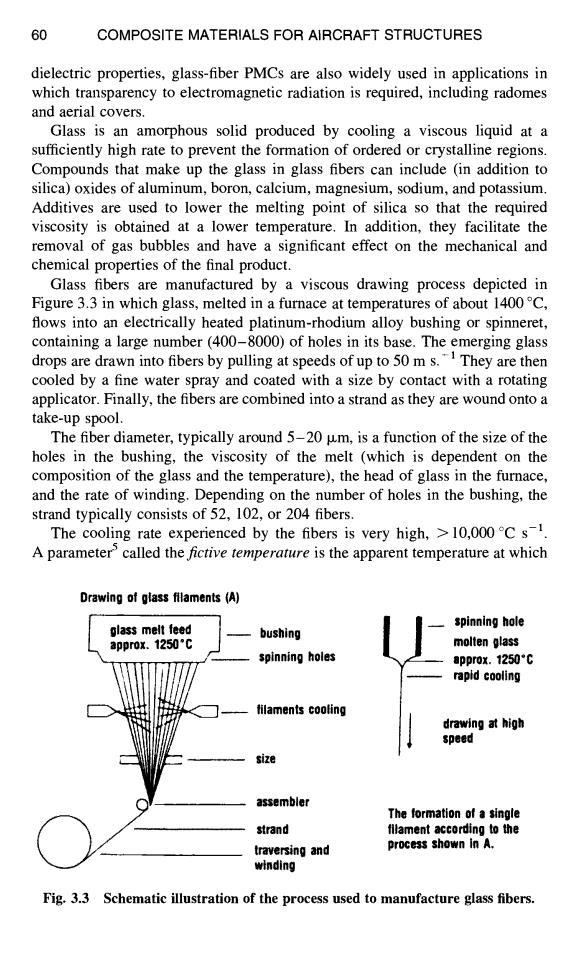正在加载图片...

60 COMPOSITE MATERIALS FOR AIRCRAFT STRUCTURES dielectric properties,glass-fiber PMCs are also widely used in applications in which transparency to electromagnetic radiation is required,including radomes and aerial covers. Glass is an amorphous solid produced by cooling a viscous liquid at a sufficiently high rate to prevent the formation of ordered or crystalline regions. Compounds that make up the glass in glass fibers can include (in addition to silica)oxides of aluminum,boron,calcium,magnesium,sodium,and potassium. Additives are used to lower the melting point of silica so that the required viscosity is obtained at a lower temperature.In addition,they facilitate the removal of gas bubbles and have a significant effect on the mechanical and chemical properties of the final product. Glass fibers are manufactured by a viscous drawing process depicted in Figure 3.3 in which glass,melted in a furnace at temperatures of about 1400C, flows into an electrically heated platinum-rhodium alloy bushing or spinneret, containing a large number(400-8000)of holes in its base.The emerging glass drops are drawn into fibers by pulling at speeds of up to 50 m s.They are then cooled by a fine water spray and coated with a size by contact with a rotating applicator.Finally,the fibers are combined into a strand as they are wound onto a take-up spool. The fiber diameter,typically around 5-20 um,is a function of the size of the holes in the bushing,the viscosity of the melt (which is dependent on the composition of the glass and the temperature),the head of glass in the furnace, and the rate of winding.Depending on the number of holes in the bushing,the strand typically consists of 52,102,or 204 fibers. The cooling rate experienced by the fibers is very high,>10,000C s-1 A parameter called the fictive temperature is the apparent temperature at which Drawing of glass filaments(A) glass melt feed spinning hole bushing appr0x.1250°C molten glass spinning holes 8ppr0x.1250°C rapid cooling filaments cooling drawing at high speed size assembler The formation of a single strand fllament according to the traversing and process shown in A. winding Fig.3.3 Schematic illustration of the process used to manufacture glass fibers.60 COMPOSITE MATERIALS FOR AIRCRAFT STRUCTURES dielectric properties, glass-fiber PMCs are also widely used in applications in which transparency to electromagnetic radiation is required, including radomes and aerial covers. Glass is an amorphous solid produced by cooling a viscous liquid at a sufficiently high rate to prevent the formation of ordered or crystalline regions. Compounds that make up the glass in glass fibers can include (in addition to silica) oxides of aluminum, boron, calcium, magnesium, sodium, and potassium. Additives are used to lower the melting point of silica so that the required viscosity is obtained at a lower temperature. In addition, they facilitate the removal of gas bubbles and have a significant effect on the mechanical and chemical properties of the final product. Glass fibers are manufactured by a viscous drawing process depicted in Figure 3.3 in which glass, melted in a furnace at temperatures of about 1400 °C, flows into an electrically heated platinum-rhodium alloy bushing or spinneret, containing a large number (400-8000) of holes in its base. The emerging glass drops are drawn into fibers by pulling at speeds of up to 50 m s.- 1 They are then cooled by a fine water spray and coated with a size by contact with a rotating applicator. Finally, the fibers are combined into a strand as they are wound onto a take-up spool. The fiber diameter, typically around 5-20 Ixm, is a function of the size of the holes in the bushing, the viscosity of the melt (which is dependent on the composition of the glass and the temperature), the head of glass in the furnace, and the rate of winding. Depending on the number of holes in the bushing, the strand typically consists of 52, 102, or 204 fibers. The cooling rate experienced by the fibers is very high, > 10,000 °C s -1. A parameter 5 called thefictive temperature is the apparent temperature at which Drawing of glass filaments (A) | gloss melt feed | bushing approx. 1250°C ,J spinning holes filaments cooling size II -- spinning hole molten glass approx, 1250*C rapid cooling drawing at high speed Q Fig. 3.3 assembler The formation of a single strand filamenl according to the traversing and process shown in A. winding Schematic illustration of the process used to manufacture glass fibers